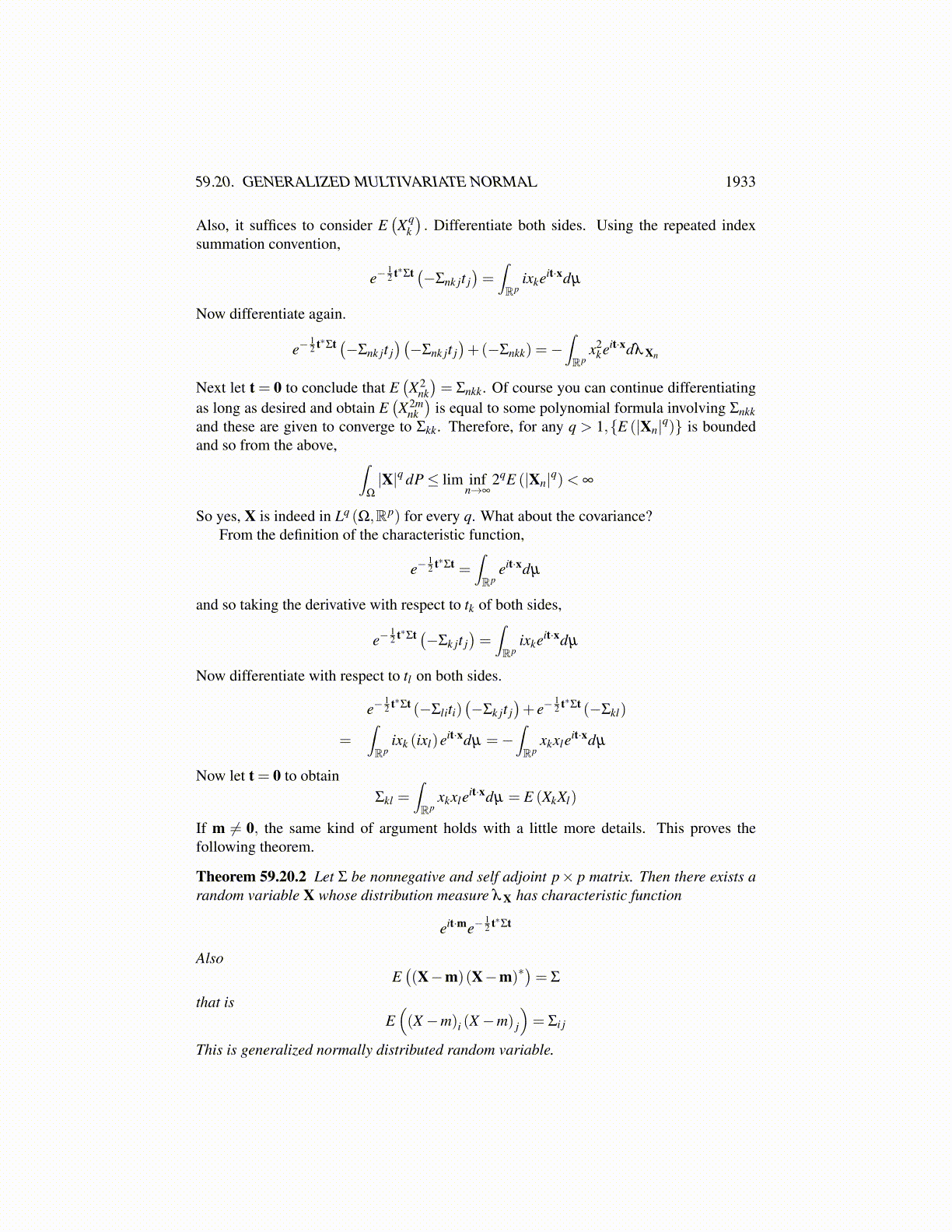
59.20. GENERALIZED MULTIVARIATE NORMAL 1933
So what if det(Σ) = 0? Is there a probability measure having characteristic equation
eit·me−12 t∗Σt?
Let Σn→ Σ in the Frobenius norm, det(Σn)> 0. That is the i jth components converge. LetXn be the random variable which is associated with m and Σn. Thus for φ ∈C0 (Rp) ,
|λ Xn (φ)| ≡
∣∣∣∣∣∫Rp
φ (x)1
(2π)p/2 det(Σn)1/2 e
−12 (x−m)∗Σ−1
n (x−m)dx
∣∣∣∣∣≤ ∥φ∥C0(Rp)
Thus these λ Xn are bounded in the weak ∗ topology of C0 (Rp)′ which is the space of signedmeasures. By the separability of C0 (Rp) and the Banach Alaoglu theorem and the Rieszrepresentation theorem for C0 (Rp)′, there is a subsequence still denoted as λ Xn whichconverges weak ∗ to a finite measure µ . Is µ a probability measure? Is the characteristicfunction of this measure eit·me−
12 t∗Σt?
Note that E(eit·Xn
)= eit·me−
12 t∗Σnt→ eit·me−
12 t∗Σt and this last function of t is contin-
uous at 0. Therefore, by Lemma 59.18.2, these measures λ Xn are also tight. Let ε > 0 begiven. Then there is a compact set Kε such that λ Xn (x /∈ Kε)< ε. Now let φ = 1 on Kε andφ ∈Cc (Rp), φ ≥ 0,φ (x) ∈ [0,1]. Then
(1− ε)≤∫Rp
φdλ Xn →∫Rp
φdµ ≤ µ (Rp)
and so, since ε is arbitrary, this shows that µ (Rp)≥ 1. However, µ (Rp)≤ 1 because
µ (Rn)≤∫Rp
ψdµ + ε ≤∫Rp
ψdλ Xn +2ε ≤ 1+2ε
for suitable ψ ∈ Cc (Rp) having values in [0,1] and n. Thus µ is indeed a probabilitymeasure.
Now what of its characteristic function?
eit·me−12 t∗Σt = lim
n→∞eit·me−
12 t∗Σnt = lim
n→∞
∫Rp
eit·xdλ Xn (x) (59.20.49)
Is this equal to ∫Rp
eit·xdµ (x)?
Using tightness again,∣∣∣∣∫Rpeit·xdµ (x)−
∫Rp
eit·xdλ Xn (x)∣∣∣∣≤ ∣∣∣∣∫Rp
eit·xdµ (x)−∫Rp
ψeit·xdµ (x)∣∣∣∣
+
∣∣∣∣∫Rpψeit·xdµ (x)−
∫Rp
ψeit·xdλ Xn (x)∣∣∣∣+ ∣∣∣∣∫Rp
ψeit·xdλ Xn (x)−∫Rp
eit·xdλ Xn (x)∣∣∣∣
≤ ε +
∣∣∣∣∫Rpψeit·xdµ (x)−
∫Rp
ψeit·xdλ Xn (x)∣∣∣∣+ ε